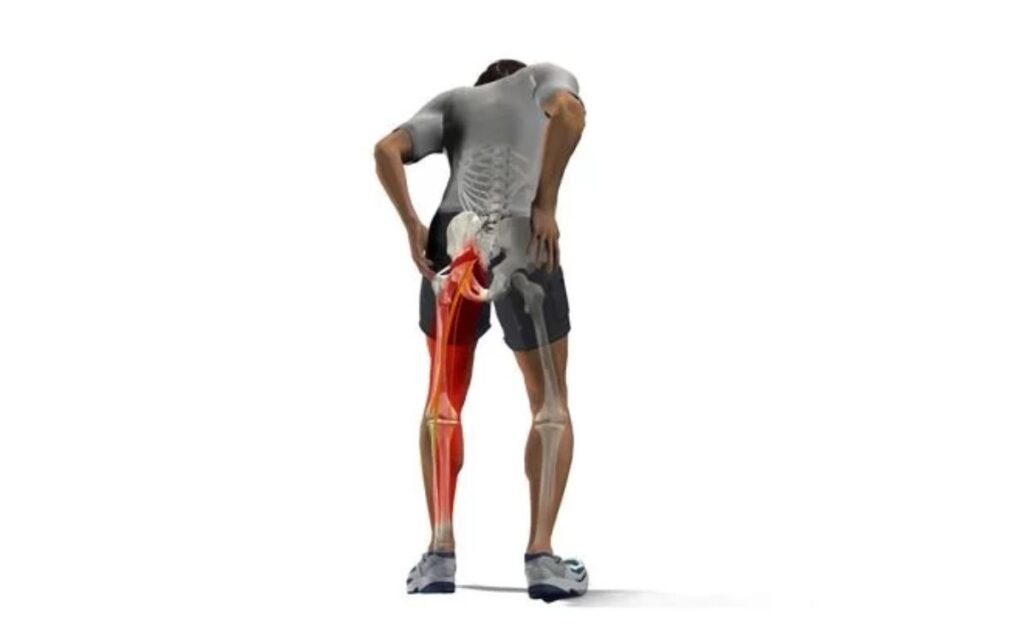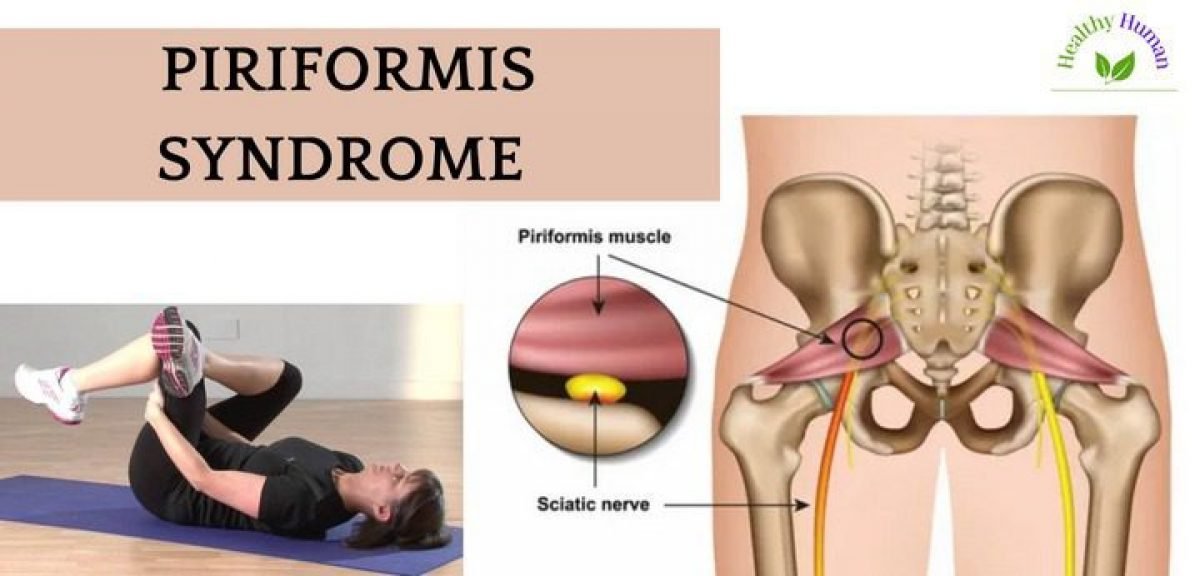A very uncommon neuromuscular condition is piriformis syndrome. When the piriformis muscle compresses the sciatic nerve, a disease calls it as piriformis syndrome develops.
The flat, band-like piriformis muscle, is situated in the buttocks just above the hip joint. Because it stabilizes the hip joint and elevates and rotates the thigh away from the body, this muscle is crucial for lower body mobility. This allows us to balance ourselves when walking and transfer our weight from one foot to the other. Additionally, employed in practically every hip- and leg-related motion in sports that entail raising and turning the thighs.
The body’s sciatic nerve is a long, thick nerve. It travels through the piriformis muscle or beside it before continuing down the back of the leg and finally splitting into smaller nerves that terminate in the foot. The piriformis muscle can spasm and result in nerve compression.
Functions of the piriformis muscle
- Assist with lower body mobility
- Stabilizes pelvis and hip joint
- Aids in raising the lower limb off the ground
- Aids in the rotation of the lower leg
Contraction of the piriformis muscle
- Stabilization of the pelvis and hip joint during walking
- Preservation of the pelvic balance during weight transfer from one leg to another
Primary causes of piriformis syndrome
A split piriformis muscle, a split sciatic nerve, or an abnormal sciatic nerve route are examples of variants of the anatomical origin of primary piriformis syndrome. Less than 15% of piriformis syndrome individuals have main explanations for their symptoms. There is currently minimal data to indicate whether the sciatic nerve abnormality causes piriformis syndrome or other kinds of sciatica. And there are no agreed statistics for the prevalence of the anomaly. These results imply that the etiology of piriformis syndrome may not be as dependent on the piriformis and sciatic abnormalities as previously believed.
Secondary causes of piriformis syndrome
A precipitating event, such as macro trauma, microtrauma, ischemic mass effect, or local ischemia, can lead to secondary piriformis syndrome.
- The most frequent (50%) cause of piriformis syndrome is macro trauma to the buttocks, which results in inflammation of soft tissue, muscular spasms, or both, and nerve compression as a result.
- The most frequent causes of PM muscle spasms include overuse, lumbar and sacroiliac joint diseases, post-surgical damage, and direct trauma.
- PS may also result from muscle shortening brought on by altered pelvic, low back, and lower limb biomechanics. The sciatic nerve may be compressed or irritated as a result. Other potential reasons include bending and twisting while picking something up off the ground, carrying heavy goods downhill while sprinting, etc. The sciatic nerve distribution, which includes the gluteal region, posterior thigh, posterior leg, and lateral part of the foot, might experience discomfort when the piriformis muscle is dysfunctional.
- Overusing the piriformis muscle, as in long-distance running or walking, or direct compression can cause microtrauma. “Wallet neuritis,” a recurrent injury brought on by sitting on hard surfaces, is an illustration of this type of direct compression.
Symptoms and signs of piriformis syndrome

The sciatic nerve’s anatomical divisions, the piriformis muscle’s anatomical changes or hypertrophy, repeated trauma, sacroiliac arthritis, and total hip replacement are other contributing causes. Additionally, Morton’s toe may put the patient at risk for piriformis syndrome. A portion of the population, notably skiers, truck drivers, tennis players, and long-distance cyclists, are at high risk.
Pain, tingling, or numbness in the buttocks are frequently the first symptoms of piriformis syndrome. The sciatic nerve’s whole length might experience intense pain (called sciatica). When doing activities like sitting in a vehicle seat or sprinting, the piriformis muscle can compress the sciatic nerve and cause discomfort.
Additionally, exerting strong pressure directly on the piriformis muscle, ascending stairs, or spending a lot of time sitting still might cause pain. However, piriformis syndrome does not cause the majority of instances of sciatica.
Also Read:- Ramsay Hunt Syndrome : Healthy Life Human
Home remedies for piriformis syndrome
A person can attempt the following when the symptoms are quite mild:
- Applying heat or ice packs
- Do massage of the whole hip-and-buttock region
- Using non-steroidal anti-inflammatory medicines over-the-counter (NSAIDs). However, one shouldn’t utilize these drugs to lessen the discomfort of exercising. In fact, one should refrain from engaging in activities like running that aggravate the discomfort.
- After a clear injury, the patient should rest.
Treatment of piriformis syndrome
A person should seek medical attention if the pain is severe, continues after a week of pain treatment, grows worse over multiple days, or is otherwise unabated. Many medical procedures can assist in reducing the piriformis syndrome’s excruciating discomfort. They include-
- Botox injections that can lessen discomfort and stop muscular spasms are available.
- Prescription drugs for pain relief or muscle relaxation. Painkillers can be addicting, therefore a person should talk to their doctor about the advantages and disadvantages of using them.
- Injections of corticosteroids or anesthetics.
- Physical treatment can help the piriformis restore its function and to stop wasting caused by underuse and dysfunction in other muscles.
- As the last option, a person may think about piriformis tendon surgery to cut the tendon where it joins to the hip or piriformis surgery to cut through the tendon to release pressure on the sciatic nerve.
Piriformis Syndrome Diagnosis

A study of the patient’s medical history, a physical examination, and sometimes diagnostic testing, are used to make the diagnosis of piriformis syndrome.
Piriformis syndrome is frequently diagnosed after clearing out other probable illnesses, such as a lumbar disc herniation or sacroiliac joint dysfunction. That might be the source of the patient’s symptoms.
- Physical exam
To determine if mobility exacerbates lower back pain or lower extremities pain, the hip and legs will be examined as part of the physical examination (sciatica pain).
Usually, moving the hip will cause discomfort to return. Through tests for local soreness and muscular strength, the examination will also detect or rule out additional reasons for sciatica pain.
- Medical background
A thorough evaluation of the patient’s symptoms is included in the medical history, together with information on how long the symptoms have been present. Whether they began gradually or after an accident, and what therapies have been attempted. It will also go through any illnesses, like arthritis, that may run in the patient’s family.
Tests for diagnosis
Whether the sciatic nerve is being inflamed at the piriformis muscle cannot be determined by X-rays or other spinal imaging procedures. To rule out other disorders that could manifest similarly to piriformis syndrome, diagnostic testing (such as X-rays, MRIs, and nerve conduction tests) may be carried out.
To determine if the piriformis muscle is the cause of the symptoms, an injection of anesthetic with or without steroids may be helpful.
Prevention for piriformis syndrome
The same stretches and exercises that can ease piriformis or deep gluteal syndrome discomfort also lower the likelihood of getting these conditions. One should always warm up before engaging in any workout. Exercises that hurt should never be done, and one should refrain from exercising until an injury has healed.
Avoiding repeated motions, applying pressure to the hips, and remaining stationary for extended periods of time may also be beneficial.
It’s crucial to spend money on supportive, well-fitting running shoes. Shoes should allow for correct movement and shouldn’t otherwise be chafe or harmed. Poorly fitted shoes can damage your form and posture.
Someone may require orthotics if they start to feel uncomfortable. These may be put into shoes to lessen any walking imbalances as well as the pressure on the piriformis muscle and the sciatic nerve.
Conclusion
The piriformis muscle can catch the sciatic nerve, resulting in piriformis syndrome. It is a component of deep gluteal syndrome, a more serious disorder. It may be ongoing and produce aches, tingling, and numbness.
People can treat their conditions at home or can consult with a doctor, depending on the severity of the disease. Both exercises and some drugs can be helpful. A person may think about surgery in serious circumstances.




